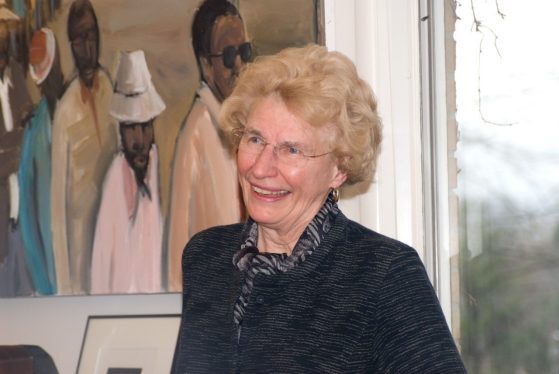
Professor emerita Ilene Forsyth (photo credit: Sally J. Bjork)
For nearly sixty years, Ilene Forsyth, professor emerita of history of art in the College of Literature, Science and the Arts, has been fiercely committed to cementing the University of Michigan’s place in the top tier of art history graduate programs. Forsyth’s latest charitable gift to the university, which brings her cumulative giving to LSA’s Department of History of Art to nearly $15 million, includes an element that aims to advance the department’s excellence and influence globally by bringing talented emerging art historians from around the world to the University of Michigan for an academic year.
One of Forsyth’s great joys as an art historian is the exchange of ideas in discovery and analysis. “Fresh thinking has always seemed to me to be stimulated by study of the work of colleagues from other, related disciplines and direct interactions with them,” Forsyth noted in the 2005 work Women Medievalists at the Academy (ed. Jane Chance).
The Forsyth Visiting Graduate Student Fellowship celebrates the spirit of intellectual partnership and exchange in the most meaningful way. Beginning in Fall 2022, the U-M Department of History of Art will offer up to four visiting graduate students, especially foreign ones, a yearlong, fully-funded fellowship (plus roundtrip airfare), enabling them to pursue their research, writing, and training with the department’s faculty, noted for the historical depth and cultural range of their expertise, as well as long-established strengths in Asian, African, Islamic, European, and North American art. Visiting graduate fellows will also have the opportunity to attend university classes, both inside and outside the art history department, if they wish.
“I am utterly thrilled about this newest gift by Ilene Forsyth, to whom the department already owes so much,” noted Professor Christiane Gruber, Chair of the Department of History of Art. “Beyond expanding our footprint at the international level, this fellowship also enables History of Art to breach through its institutional borders. We thus will be able to reach the most diverse set of graduate students possible, including, most vitally, American and foreign students who have less privileged access to scholarly and financial resources.”
Central to the fellowship is the expectation that visiting fellows will bring those fresh social and cultural perspectives that Professor Forsyth so treasured, and that they will broaden and enrich the department’s graduate cohort on a continual, yearly basis. Further, Forsyth was energized by the promise of collegial relationships that will be forged within each cohort, as visiting fellows and LSA graduate students work alongside one another. This uniting of a global intellectual network of art historians rising up together as colleagues, and fanning out to universities nationally and internationally to expand U-M’s footprint, is key to Forsyth’s vision and greatest hope for firmly establishing the department as a magnet for the advanced study of art history at the global level.
Forsyth is celebrated in her field for her adroit ability to consider–and see–works in new ways according to both their social and functional contexts, and as a professor she was deeply dedicated to developing the skill in her students. With the Forsyth Visiting Graduate Student Fellowship, Forsyth’s legacy expands, elevating the department in new ways by encouraging its members to consider new perspectives, and creating impact at multiple levels, from students to faculty, from LSA to the field of art history and other cultural and artistic traditions worldwide. Her generous support will position the Department of History of Art, along with its expertise, research, and teaching, at the center of increasingly robust intellectual and interdisciplinary conversations unfolding at the global level.


